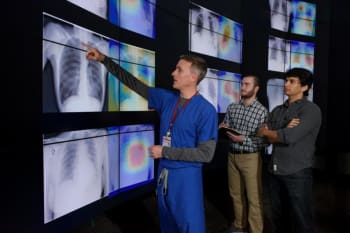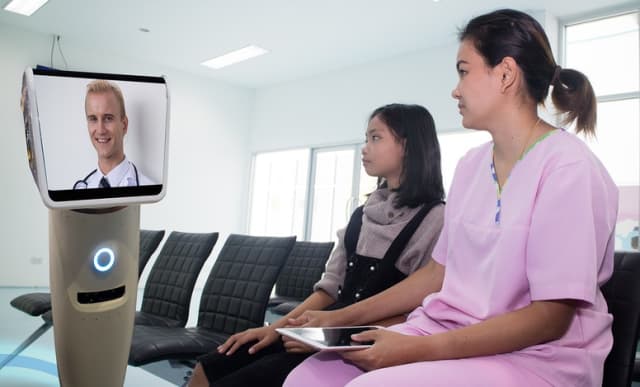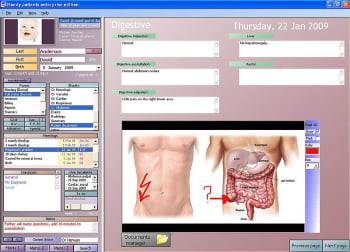One of the hottest tech trends these days is artificial intelligence (AI), with researchers looking into the use of AI for applications ranging from autonomous vehicles to financial management, to healthcare.
The healthcare industry is often at the forefront of innovation and technological advances due to the wealth of medical devices, equipment and processes that permeate the industry. But AI in particular seems poised to transform the way we collect, understand and use data on patient health, healthcare services and historical health data to revolutionize medical diagnostics, treatment and research.
What makes AI so suitable for use in medical research and the healthcare industry?
Largely, the appeal of AI is its ability to collect, analyze and make sense of vast amounts of unstructured and variable data—especially text, statistical numbers, and visual images—quickly and often more accurately than a human being. With the increase in digitization and computing power, there has been an ever-growing wealth of digital data produced by individuals and systems, and advances in machine learning and analytical algorithms mean AI systems will become ever more powerful and effective at performing their assigned tasks.
Want to publish your own articles on DistilINFO Publications?
Send us an email, we will get in touch with you.
We’re already seeing innovative research into applications of AI across the medical and healthcare industries—some applications already seeing use, others still in development or testing but showing great promise.
AI for Diagnostics
Determining a patient’s diagnosis is a vital aspect of healthcare. Care providers and medical researchers alike can see the useful potential of using AI to augment or replace the human ability to identify illness and disease.
Medical Imaging

Radiologist Matthew Lungren, left, meets with graduate students Jeremy Irvin and Pranav Rajpurkar to discuss the results of detections made by theCheXNet algorithm. A tool the researchers developed along with the algorithm produced these images, which are similar to heat maps and show the areas of the X-ray most indicative of pneumonia. (Image courtesy of Stanford University/L.A. Cicero)
Diagnosing patients according by examining medical images is a prime candidate for the application of AI systems to improve both the speed and accuracy of performing these tasks. As such, the development of algorithms and machine learning systems is one of the big research areas for healthcare AI.
In particular, medical imaging is ideal for AI because we already possess a wealth of medical scans, collected, categorized and stored at medical institutions across the country—many of which are digital, or undergoing the digitization process. These massive collections of image data can be used to train AI systems not only to perform the collection and categorization of scans, but to analyze these medical images to identify a myriad of health conditions—everything from bone fractures to pneumonia to cancer.
A sufficiently sophisticated system will also be able to aggregate image data with other types of medical data, and offer predictive diagnoses to individual patients, or wider statistical data on occurrences of disease across the population.
The Stanford University research project CheXNet is one example, an AI algorithm designed to diagnose pneumonia based on patient chest x-rays. Their algorithm trained on a dataset of 112,120 frontal-view chest x-ray images that were initially released by the National Institutes of Health Clinical Center. The collection of images was labelled with up to 14 different pathologies, alongside an algorithm that offered some success identifying some of said pathologies. The public release of the dataset was intended to encourage other researchers to advance the original work, which the Stanford team took to heart.
Even the most skilled doctor or radiologist is capable of a misdiagnosis due to how difficult it can be to distinguish specific diseases based on x-ray images.
“The motivation behind this work is to have a deep learning model to aid in the interpretation task that could overcome the intrinsic limitations of human perception and bias, and reduce errors,” explained Matthew Lungren, professor of radiology at Stanford and part of the research team. “More broadly, we believe that a deep learning model for this purpose could improve health care delivery across a wide range of settings.”
After a month of continuous iteration, the team’s algorithm was able to beat the identification standards for all 14 of the possible pathologies in the original dataset, and outperformed four individual Stanford radiologists in determining pneumonia diagnoses.
Similar success has been seen in a Harvard Medical School and Beth Israel Deaconess Medical Center research collaboration into AI-assisted pathology, where deep learning is used to train an algorithm to detect and diagnose tumors.
This algorithm integrated multiple speech recognition and image recognition processes, and the research study showed the algorithm achieved a 92% success rate compared to human pathologists’ 96%; but when the algorithmic and human results were combined, the accuracy rate reached 99.5%.
Mental and Physical Health Screening
Another aspect of healthcare that is primed for assistive AI—in some cases, already seeing the use of AI—is the diagnostic screening process. This is typically performed by a patient speaking with a doctor or other healthcare professional and answering a series of questions about their medical history and describing symptoms, which the health care provider uses to make a diagnosis or recommend a course of action for the patient.
As AI systems built around natural language recognition and processing become increasingly adept at interacting with human users, researchers are developing AI tools that can perform these initial diagnostic assessments—most often in the form of chatbots over a smartphone or computer interface.
This is essentially the concept of Telemedicine, which already exists and is available in many parts of the world. Patients have remote access to a healthcare provider and the ability to interact, ask questions and receive healthcare advice. Most current telemedicine systems use connective technologies including live chat, video calling or regular telephone service to connect patients with doctors or nurses. There are several systems operating in the U.S. offering telemedicine services, but these systems are especially vital to third-world and developing nations where there is little to no formal healthcare infrastructure, and no regular local healthcare providers.

Using AI for telemedicine will solve one of the biggest roadblocks to these systems’ widespread use: the need for human doctors and nurses at the other end of the line. An advanced AI that is capable of interacting with patients and making accurate diagnoses at the screening process will enable these programs to grow in availability and scope.
These kinds of AI-powered chatbots will be a key factor in preventative healthcare. Advanced chatbot systems will use speech or text recognition to compare the symptoms and medical history provided by the patient against a database of symptoms, diseases and diagnoses, and respond with a recommended course of action—such as going to the pharmacy to pick up over-the-counter cold medicine, dialling 911 or another emergency service hotline, or going directly to the hospital.
Diagnosing illness is only part of the healthcare process, of course, but these chat-based AI systems can be combined with other types of digital and AI-monitored sensors, wearables and medical devices to accumulate a complete picture of the patient’s health and offer personalized healthcare.
AI for Patient Care and Treatment
Personalized healthcare is one of the overarching goals driving the development of healthcare AI systems. This can include AI systems that perform personalized assessments and offer health care advice, assist patients with managing drug regimens and chronic medical conditions, or powering robotic systems to support patients living at home with conditions such as dementia and Alzheimer’s, mobility issues, or other mental and physical disabilities.
Berlin-based Ada Health is an example of this type of AI-driven health monitoring tool. The platform combines an AI chatbot that interacts with the patient, and machine learning capabilities to track patient health, and combine patient symptoms with other data to offer possible diagnoses and recommendations.
AI will also be crucial to planning and resource allocation when it comes to healthcare and social care services. By learning from and leveraging data collected from patients, electronic health records, historical health information and data on the financial, personnel and infrastructure available across the industry, these AI systems will be able to maximize and optimize clinical care and treatment resources.
IBM Watson Care Manager is one such system, which examines patient needs and available healthcare resources in order to match individual patients with the care providers and support that will meet their needs and fit their allocated care budget. The Care Manager system can also design individualized care plans, and determine the most effective use of care management resources.
Overall, the widespread introduction of AI into this field is expected to improve some of the current health industry crises, such as lack of availability of doctors, nurses and other clinically trained staff, long wait times in hospitals and clinics, and long wait times for specialized surgeries and other procedures. By allowing AI to handle the large volume of simple care and diagnostic tasks, the human experts can redirect their efforts to specialized and complex care or emergency medicine.
AI could provide the same outcomes to patient monitoring and symptom or drug management regimens. Where at present many aspects of these processes —such as regular doctor visits, blood glucose testing and reporting, or tracking symptoms in journals—require patients to interact directly with their health care providers, using AI to perform those routine monitoring tasks will free up doctors and nurses to attend to more complex cases. These AI would send the data to a patient’s doctor or care team, including recommended actions when there are points of concern, and the patient’s primary physician could follow up in person only as necessary.
AI in Medical Research

An example of a patient’s Electronic Health Record. (Image: Wikipedia.)
These individual applications of AI all tie into the larger picture of using AI in medical research of all kinds, in order to identify trends in the industry or in the population, design or discover new drugs or drug combinations, and match patients to clinical trials or research studies.
The development of the electronic health record has been an important step in the overall digitization of the medical industry over the last several decades. Data in the EHR isn’t just vital to day-to-day patient care activities; it also becomes a great resource for medical research as a dataset of patient information.
This data the EHR holds is invaluable for medical research, but it remains a resource that is difficult to effectively use due to its jumbled nature of data formats, differently structured inputs, and various levels of completion, making it difficult to extract meaningful analytical data to support predictive and clinical care decisions.
That’s not to mention the constant stream of new information being added to the EHR each day, at every hospital and doctor’s visit.
AI is ideal for parsing through this type of vast, disparate data and identifying patterns faster and with greater precision compared to human researchers and analysts. AI systems could also search scientific publications, determine relevant studies, or correlate identified symptoms or illnesses with results in research studies and the EHR to aid physicians in identifying and predicting disease probabilities for individual patients, or even at the public health scale.
The goal here is to use AI to bring together all sources of human health data—historical record, the modern EHR, new patient data, research studies, clinical trials, drug and device development, and more—and to analyze it all, identify important correlations, offer recommendations for treatment, and predictive analytics for diagnosis, then put this distilled information directly into the hands of front line healthcare professionals.
Drug Discovery

A particularly relevant subset of medical research is drug discovery. Research into developing new drugs has historically been a long and arduous process. According to the US Food and Drug Administration, the drug discovery process involves five stages for the development and entry onto the market for new drugs:
- Discovery and development
- Preclinical research
- Clinical research
- FDA review
- FDA post-market safety monitoring
This typically comes with a price tag of US$2.55 billion, and a timeline of 10 years of more.
The introduction of AI systems is seen as the solution to faster, cheaper and more efficient drug discovery, able to crunch large amounts of data, perform multiple iterations of compound simulation and modelling, and recognizing patterns in data that will lead to drugs that are more effective. We may also see drugs that are tailored to each individual’s biological health profile, a key aspect of personalized healthcare.
“AI is going to lead to the full understanding of human biology and give us the means to fully address human disease,” said Thomas Chittenden, who leads a team at drug discovery firm Wuxi NextCODE in Cambridge, Massachusetts. “The way we develop drugs and assess them in clinical trials will all come down to very sophisticated pattern recognition.”
With AI reducing the cost—both in money and in time—of the development of new drugs, not only will patients have access to effective drugs and treatments sooner, but ideally at a much lower cost.
Typically, advances in drug discovery are due to finding new insights into a disease, identifying and testing drug compounds to determine their possible beneficial effects, and repurposing existing drugs against different diseases.
AI will make all of these processes easier and faster. Drug discovery derives its insights into disease from a massive pool of data, including high-resolution medical images, genomic profiles, molecular structures and biological information, largely published in papers, journals and medical trial reports. Human researchers typically only read a few hundred published medical articles per year, out of the thousands that are available.
Using AI to read, analyze and correlate these articles presents a much more efficient solution. For example, Pfizer has been using the IBM Watson for Drug Discovery cloud-based platform, which has access to 25 million article abstracts and one million medical journal articles. This iteration of Watson can review scientific papers, and provide insights for Pfizer’s immune-oncology drug research.
The processes for finding new drug effects by testing molecular compounds is complicated due to the sheer number of countless combinations to examine. The process of analyzing all the necessary data is complex and time consuming when done by human researchers, even with the existing assistance digital records and computer analytics. The expectation is that AI systems with machine learning capabilities will be able to perform this analysis faster and more accurately.
The machine learning algorithms will also enable faster analysis of existing drugs to determine how they can be repurposed, lowering development costs and making them available to patients sooner.
Personalized Health Care is the Future
Personalized healthcare is the name of the game, and AI is considered to be the best path to reach this outcome. The massive data analysis capabilities of deep learning AI systems promise faster and more accurate diagnoses, custom treatment and clinical care plans, and cheaper, more effective drugs tailored to each patient’s disease and needs–and these applications are just the tip of the iceberg. Though it’s still early days, the achievements already made by AI in healthcare are exciting, and point to a healthy future.
Date: October 11, 2018
Source: Engineering.com







